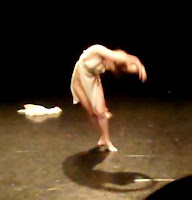Dance history is ripe with relationships between visual artists and dancers. Most of us are at least familiar with Edgar Degas’ iconic paintings of the nineteenth-century ballet. Dancers have long been idealized models for visual artists of many mediums. (I even posed as a “Degas ballerina” for art students at The Girls’ School of Austin last year—and art teacher Nancy Hoover painted a fun Duncan dance portrait for me in exchange!). With regard to this history of dancers inspiring visual artists, Isadora Duncan’s dance art is no exception.
 |
| "Sky Dance" by Nancy Hoover, 2010 |
Duncan dance history is inextricably linked with the visual arts, for not only did Duncan take the line and shape of her dance movement from Ancient Greek and European Renaissance painting and sculpture, she also inspired a generation of visual artists to attempt to capture her ephemeral essence through their own, seemingly more tangible, mediums. Duncan’s dance fueled the artistic imaginations of artists from Auguste Rodin and Emile-Antoine Bourdelle to Jose Clara and Abraham Walkowitz. Walkowitz, in particular, created an enormous body of work dedicated to Duncan. In the absence of significant film footage recording Duncan’s movement, Walkowitz’s line drawings and watercolors are an invaluable resource for dance artists and historians seeking to understand the quality of Duncan’s expressive dance movement and the feeling it evoked.
The artistic relationship between Duncan and Walkowitz forms the subject of dance scholar Ann Cooper Albright’s latest book, Modern Gestures: Abraham Walkowitz Draws Isadora Duncan Dancing. In this picturesque volume, Cooper Albright curates a selection of Walkowitz’s watercolors of Duncan, weaving the artists’ biographies into a narrative exploring the interplay of rhythm, line, and space in their work. She delves into an interesting inquisition into the nature and purpose of repetition in Walkowitz’s reproductions of Duncan’s dancing figure, noting that Walkowitz captured something in his painting that communicated the actual experience of witnessing Duncan’s dancing, an effect that film footage of that era could not possibly have conveyed.
 |
She relates a rumor that, at some point, Walkowitz envisioned a flipbook of his pictures of Duncan dancing—a idea that prompted me to fan through the final pages of the book in an attempt to view Cooper Albright’s choreographic sequence of Walkowitz images, carefully ordered at the end of the volume, as if they were in motion. While an interesting experiment, I much prefer fanning through the pages at a slower pace, allowing the sensation, of observing each image individually, echo in that space between sight and kinesthetic reception. I think this mode of experiencing the work is more aligned with Duncan rhythm anyway. Flipbooks allot the same amount of time to each image, just as film conveys a set number of frames per second. This mode of delivery flattens out the experience of anacrusis (thank you Cherlyn) that defines Duncan rhythm. I have been too well-trained in the “and” count, or that “breath upon breath” (thanks to Lori) moment of suspension before the downbeat to ever be satisfied with that!
These images (above and below), while cut from video, convey the weight shift and suspension in the body similar to what Walkowitz was able to capture in his paintings (and would have been impossible to capture by the still photography of Duncan's time).
So, this long history relating Duncan dance and the visual arts sets the scene for my upcoming collaboration with Divergence Vocal Theater—as I’ll be dancing next Saturday, January 15th at 2:30pm, as part of “Gallery Conversations” at the Museum of Fine Arts Houston. The performance is free with museum admission, and if you are interested in experiencing Duncan’s dance movement yourself, join me for an afternoon workshop on Sunday, January 16th from 2-5pm at Houston’s NiaMoves.
